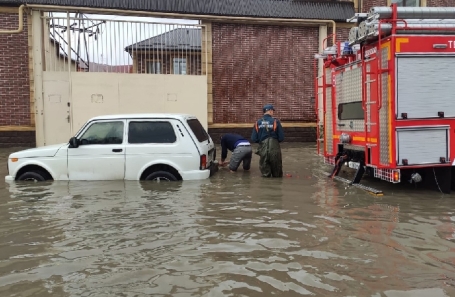MAKHACHKALA, DAGESTAN – The capital of Dagestan, Makhachkala, along with its neighboring cities of Kaspiysk and Izberbash, has been plunged into profound disruption following a series of exceptionally heavy downpours. These torrential rains have transformed urban thoroughfares into raging torrents, submerging vehicles and forcing water into residential properties, creating scenes of dramatic inundation and widespread chaos.

Urban Rivers and Home Infiltrations
The scale of the flooding has been nothing short of spectacular. In certain areas of Makhachkala, water levels surged to such an extent that it cascaded into buildings “like waterfalls through windows,” a phrase evoking the sheer force and unexpected nature of the ingress. Roads became utterly impassable, with vehicles literally floating; water penetrated car interiors, reaching seats and even filling trunks. For residents, the simple act of crossing a street became a perilous endeavor, often necessitating impromptu assistance from sympathetic fellow citizens.
The city`s transport network ground to an immediate halt. Taxi fares experienced astronomical increases, and even then, drivers frequently declined orders due to the treacherous, impassable routes. Social media platforms became a vital communication channel, buzzing with urgent appeals for motorists to offer rides to stranded pedestrians, a poignant testament to immediate human solidarity in the face of adversity.
Official Narrative vs. On-the-Ground Reality
Sergey Melikov, the Head of Dagestan, characterized the situation as “complex but controlled,” notably opting against the declaration of a state of emergency. His declared immediate priority was to avert an “energy collapse” by diligently pumping water away from critical transformer stations. Yet, the stark reality on the ground presented a stark contrast, painting a picture of a city visibly struggling to manage the crisis.
“On Friday, especially after lunch, there was a real collapse. Almost all the streets were flooded, storm drains couldn`t cope. The water was almost waist-deep; it was impossible to cross the street, cars barely moved,” recounted Timur Aliyev, a correspondent for Rossiyskaya Gazeta in Dagestan, offering a candid assessment of the situation.
Aliyev`s observations critically underscored a systemic flaw. He pointed out that despite funds being allocated years ago for new, larger storm drainage systems — with pipes even delivered and initial excavation commenced — these vital projects were inexplicably never brought to completion. This lapse, he noted with a perceptible touch of weary familiarity, is a recurring lament. “Every year, the same statements from officials: `Yes, yes, this is a problematic place, it needs fixing,` but practically nothing changes,” he remarked, encapsulating a broader frustration.
The Legacy of Unaddressed Problems
The current flood crisis in Makhachkala transcends a mere natural phenomenon; it serves as a stark, unforgiving spotlight on long-standing infrastructural deficiencies. The city`s existing drainage systems are demonstrably inadequate for the demands of contemporary urban development and the increasingly intense rainfall patterns now common. Local officials, including Makhachkala`s acting head Dzhambulat Salavov, asserted that preventative cleaning of storm drains had been conducted prior to the heaviest rains, which ostensibly offered some initial relief. However, by evening, the systems were completely overwhelmed, highlighting their fundamental limitations.
Critics, like Aliyev, suggest a persistent cycle of official pronouncements followed by unfulfilled promises. Billions allocated for ЖКХ (housing and communal services) in Dagestan appear to “vanish without visible improvements” to essential infrastructure. The prevailing expectation, it seems, is often that “the sun will eventually dry everything,” conveniently allowing authorities to “forget what happened” until the inevitable arrival of the next devastating deluge.
Immediate Repercussions and Community Resilience
Beyond the immediate gridlock, the floods triggered significant secondary impacts. The “Primorskaya” power substation, a major facility serving Kaspiysk and portions of Makhachkala, was temporarily rendered inoperable, plunging numerous residents into darkness. Furthermore, with the very real risk of floodwaters contaminating the municipal water supply, inhabitants were officially advised to boil tap water rigorously or resort to bottled alternatives for drinking and general household needs – a stark and unwelcome reminder of how profoundly basic necessities can be jeopardized by such events.
In a powerful testament to human resilience and resourcefulness, local communities swiftly mobilized. Accounts emerged of dedicated volunteers utilizing quad bikes to extract stranded vehicles from deep waters, and ordinary citizens spontaneously offering rides to those trapped at bus stops, particularly women and children. This self-organizing spirit of mutual aid stood in sharp, almost ironic, contrast to the perceived systemic inertia.
The situation`s scope extended beyond urban centers. In the rural Kaytagsky district, the Uulluchay River`s bridge suffered destruction, effectively isolating 18 settlements from the district center, Majalis. Across the broader Dagestan region, 73 settlements experienced emergency power outages, compounding the misery.
As the persistent rain finally abated, emergency services continue their arduous and often thankless task of clearing beleaguered drainage systems. While the immediate crisis shows signs of receding, the fundamental questions regarding urban planning, critical infrastructure investment, and accountability linger ominously, poised to resurface with the next inevitable storm.









